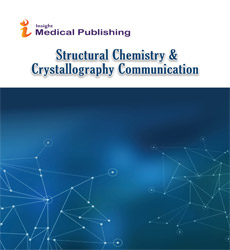NMR CRYSTALLOGRAPHY AS A TOOL FOR CHARACTERIZATION OF ACTIVE SITES OF SOLID CATALYSTS
3rd Edition of International Conference on Advanced Spectroscopy, Crystallography and Applications in Modern Chemistry
June 04-05, 2018 London, UK
Olga B. Lapina, A.A. Shubin and E. Papulovsky
Boreskov Institute of catalysis, Russia Novosibirsk State University, Russia
ScientificTracks Abstracts: Struct Chem Crystallogr Commun
DOI: 10.21767/2470-9905-C1-005
Abstract
NMR crystallography combines state-of-the-art highresolution solid-state NMR experiments with state-of-theart quantum chemistry calculations thus allowing determining structural and dynamic characteristics in a variety of systems. In this work, we are going to demonstrate different steps of NMR crystallography approaches with an example of supported oxide catalysts. The recent advances in NMR of oxide-based systems are primarily associated with the achievements in NMR spectroscopy of quadrupolar nuclei since the majority of NMR-observable isotopes of elements composing oxide systems possess quadrupole moments. Ultra-high magnetic fields (up to 23.5 T), ultra-high sample spinning (~ 100 kHz), as well as modern electronic components and devices together with a number of software programs allowing researchers to extract parameters of chemical shift and nuclear quadrupole interaction tensors, as well as their mutual orientation. The first step of the study was to test NMR crystallography approach on individual compounds. After, experimental NMR parameters of real catalysts were determined. Based on values obtained, several sets of models were proposed. For suggested models, NMR parameters were calculated by DFT. When a good matching between experimental and calculated NMR parameters was achieved, it was concluded that the 3D structure of surface sites is identified. It is very important that NMR crystallography in application to catalysts could serve not only for characterization of structure of surface sites, but also for characterization of their catalytic activity, for this we have to check catalytic activity of different sites by probe molecules (both experimentally and theoretically). The next step was connected with adsorption of test molecules (H2O, CO2, CH3OH, etc.) on real catalysts (experimental part) and on model surface sites (theoretical part). At this stage, it is reasonable to use additional experimental techniques (for instance, FTIR). In case of good agreement between experimantal and theoretical parameters, it is possible to determine 3D structures of active sites.
Acknowledgements: Authors thank funding provided via RFBR projects â�?�? 17-03-00531. Recent Publications 1. O.B. Lapina, V.V. Terskikh (2012) Quadrupolar Metal NMR of Oxide Materials Including Catalysts’ Chapter 27, in NMR of Quadrupolar Nuclei in Solid Materials. Wasylishen, R.E., Ashbrook, S.E. and Wimperis, S. (eds). John Wiley & Sons Ltd, Chichester, UK, pp 467494. 2. O.B. Lapina, (2017), Modern ssNMR for heterogeneous catalysis, Catal. Today, 285, 179. 3. E. Papulovskiy, D.F. Khabibulin, V.V. Terskikh, E.A. Paukshtis, V. M. Bondareva, A.A. Shubin, A.S. Andreev, and O.Lapina, (2015) Effect of Impregnation on the Structure of Niobium Oxide/Alumina Catalysts Studied by Multinuclear Solid-State NMR, FTIR, and Quantum Chemical Calculations, J. Phys. Chem.C, 119, 10400−10411. 4. A.S. Andreev , N.V. Bulina, M.V. Chaikina, I.Yu. Prosanov, V.V. Terskikh, O.B. Lapina, (2017) Solidstate NMR and computational insights into the crystal structure of silicocarnotite-based bioceramic materials synthesized mechanochemically, Solid State Nuclear Magnetic Resonance 84, 151–157. 5. A.S. Andreev, Ð�?.A. Kazakova, A.V. Ishchenko, A.G. Selyutin, O.B. Lapina, V.L. Kuznetsov, J.-B.d’Espinose de Lacaillerie, (2017) Magnetic and dielectric properties of carbon nanotubes with embedded cobalt nanoparticles, Carbon, 114, 39-49 6. I.V. Yakovlev, A.M. Volodin, E.S. Papulovskiy, A.S. Andreev, O.B. Lapina, (2017) Structure of CarbonCoated C12A7 Electride via Solid-State NMR and DFT Calculations, J.Phys.Chem.C 121, 22268. 7. A.S. Andreev, D.V. Krasnikov, V.I. Zaikovskii, S.V. Cherepanova, M.A. Kazakova, O.B. Lapina, V.L. Kuznetsov, J.–B. d’Espinose de Lacaillerie, (2018) Internal field 59Co NMR study of cobalt-iron nanoparticles during the activation of CoFe2/CaO catalyst for carbon nanotube synthesis, Journal of Catalysis 358 62–70.
Biography
Olga B.Lapina, Graduated Novosibirsk University (1976), received PhD in 1984, Prof. Dr.S. from1995. Leading Researcher, Head of SSNMR group of Boreskov Institute of Catalysis, Novosibirsk, Russia. She has extensive expertise in modern multinuclear solid-state NMR spectroscopy and applications of magnetic resonance techniques in materials sciences and catalysis. She has been a chair of several international conferences (including EUROMAR-2008) and workshops. Last years she works on application of NMR crystallography for catalyst characterization. (ORCID 0000-00029911-7617). Email:olga@catalysis.ru
Google Scholar citation report
Citations : 275
Abstracted/Indexed in
- Google Scholar
- China National Knowledge Infrastructure (CNKI)
- Directory of Research Journal Indexing (DRJI)
- WorldCat
- Geneva Foundation for Medical Education and Research
- Secret Search Engine Labs
- CAS (Chemical Abstracting Services)
Open Access Journals
- Aquaculture & Veterinary Science
- Chemistry & Chemical Sciences
- Clinical Sciences
- Engineering
- General Science
- Genetics & Molecular Biology
- Health Care & Nursing
- Immunology & Microbiology
- Materials Science
- Mathematics & Physics
- Medical Sciences
- Neurology & Psychiatry
- Oncology & Cancer Science
- Pharmaceutical Sciences

